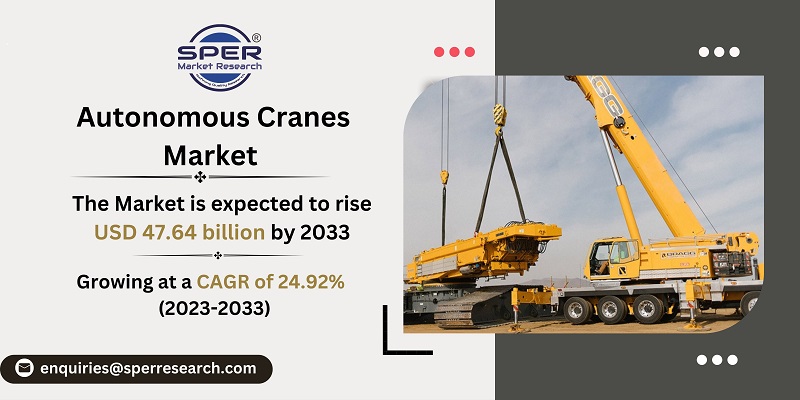
Autonomous Cranes Market Growth, Size, Trends, Revenue, Demand, Challenges and Future Scope
Autonomous Cranes Market Size- By Mobility, By Business Type, By End User- Regional Outlook, Competitive Strategies and Segment Forecast to 2033
| Published: Jul-2023 | Report ID: MACH2342 | Pages: 1 - 214 | Formats*: |
| Category : Equipment and Machinery | |||
- Increasing Construction and Renovation Activities: A variety of stakeholders, including heavy equipment service providers, professionals in infrastructure development, governmental organisations, and others, are anticipated to drive demand for automated crane solutions. The need for greater operational effectiveness and better safety measures is what is driving this demand.
- Enhanced Operational Efficiency: Autonomous cranes increase material handling efficiency, enabling quicker and more precise operations. Costs are reduced as a result of increased efficiency, and productivity is increased.


| Report Metric | Details |
| Market size available for years | 2019-2033 |
| Base year considered | 2022 |
| Forecast period | 2023-2033 |
| Segments covered | By Mobility, By Business Type, By End User |
| Regions covered | Asia Pacific, Europe, Middle East and Africa, North America, Latin America |
| Companies Covered | AIDrivers Ltd, Cargotec Corporation, Columbus McKinnon, INTSITE Ltd., Komatsu Ltd., Konecranes Plc, Schneider Electric, SMIE, Syracuse, VOCA |
- Construction Companies
- Manufacturing and Industrial Facilities
- Port and Harbor Authorities
- Mining and Extraction Companies
- Energy and Utility Sector
- Others
| By Mobility: |
|
| By Business Type: |
|
| By End User: |
|
- Global Autonomous Cranes Market Size (FY’2023-FY’2033)
- Overview of Global Autonomous Cranes Market
- Segmentation of Global Autonomous Cranes Market By Mobility (Mobile, Static)
- Segmentation of Global Autonomous Cranes Market By Business Type (Aftermarket, OEM)
- Segmentation of Global Autonomous Cranes Market By End-User (Building & Construction, Marine & Offshore, Mining & Excavation)
- Statistical Snap of Global Autonomous Cranes Market
- Expansion Analysis of Global Autonomous Cranes Market
- Problems and Obstacles in Global Autonomous Cranes Market
- Competitive Landscape in the Global Autonomous Cranes Market
- Impact of COVID-19 and Demonetization on Global Autonomous Cranes Market
- Details on Current Investment in Global Autonomous Cranes Market
- Competitive Analysis of Global Autonomous Cranes Market
- Prominent Players in the Global Autonomous Cranes Market
- SWOT Analysis of Global Autonomous Cranes Market
- Global Autonomous Cranes Market Future Outlook and Projections (FY’2023-FY’2033)
- Recommendations from Analyst
1.1. Scope of the report1.2. Market segment analysis
2.1. Research data source
2.1.1. Secondary Data2.1.2. Primary Data2.1.3. SPER’s internal database2.1.4. Premium insight from KOL’s2.2. Market size estimation2.2.1. Top-down and Bottom-up approach2.3. Data triangulation
4.1. Driver, Restraint, Opportunity and Challenges analysis4.1.1. Drivers4.1.2. Restraints4.1.3. Opportunities4.1.4. Challenges4.2. COVID-19 Impacts of the Global Autonomous Cranes Market
5.1. SWOT Analysis5.1.1. Strengths5.1.2. Weaknesses5.1.3. Opportunities5.1.4. Threats5.2. PESTEL Analysis5.2.1. Political Landscape5.2.2. Economic Landscape5.2.3. Social Landscape5.2.4. Technological Landscape5.2.5. Environmental Landscape5.2.6. Legal Landscape5.3. PORTER’s Five Forces5.3.1. Bargaining power of suppliers5.3.2. Bargaining power of buyers5.3.3. Threat of Substitute5.3.4. Threat of new entrant5.3.5. Competitive rivalry5.4. Heat Map Analysis
6.1. Global Autonomous Cranes Market Manufacturing Base Distribution, Sales Area, Product Type6.2. Mergers & Acquisitions, Partnerships, Product Launch, and Collaboration in Global Autonomous Cranes Market
7.1. Global Autonomous Cranes Market Value Share and Forecast, By Mobility, 2023-20337.2. Mobile7.3. Static7.4. Others
8.1. Global Autonomous Cranes Market Value Share and Forecast, By Business Type, 2023-20338.2. Aftermarket8.3. OEM8.4. Others
9.1. Global Autonomous Cranes Market Value Share and Forecast, By End User, 2023-20339.2. Building & Construction9.3. Marine & Offshore9.4. Mining & Excavation9.5. Others
10.1. Global Autonomous Cranes Market Size and Market Share
11.1. Global Autonomous Cranes Market Size and Market Share By Mobility (2019-2026)11.2. Global Autonomous Cranes Market Size and Market Share By Mobility (2027-2033)
12.1. Global Autonomous Cranes Market Size and Market Share By Business Type (2019-2026)12.2. Global Autonomous Cranes Market Size and Market Share By Business Type (2027-2033)
13.1. Global Autonomous Cranes Market Size and Market Share By End User (2019-2026)13.2. Global Autonomous Cranes Market Size and Market Share By End User (2027-2033)
14.1. Global Autonomous Cranes Market Size and Market Share By Region (2019-2026)14.2. Global Autonomous Cranes Market Size and Market Share By Region (2027-2033)14.3. Asia-Pacific14.3.1. Australia14.3.2. China14.3.3. India14.3.4. Japan14.3.5. South Korea14.3.6. Rest of Asia-Pacific14.4. Europe14.4.1. France14.4.2. Germany14.4.3. Italy14.4.4. Spain14.4.5. United Kingdom14.4.6. Rest of Europe14.5. Middle East and Africa14.5.1. Kingdom of Saudi Arabia14.5.2. United Arab Emirates14.5.3. Rest of Middle East & Africa14.6. North America14.6.1. Canada14.6.2. Mexico14.6.3. United States14.7. Latin America14.7.1. Argentina14.7.2. Brazil14.7.3. Rest of Latin America
15.1. AIDrivers Ltd15.1.1. Company details15.1.2. Financial outlook15.1.3. Product summary15.1.4. Recent developments15.2. Cargotec Corporation15.2.1. Company details15.2.2. Financial outlook15.2.3. Product summary15.2.4. Recent developments15.3. Columbus McKinnon15.3.1. Company details15.3.2. Financial outlook15.3.3. Product summary15.3.4. Recent developments15.4. INTSITE Ltd.15.4.1. Company details15.4.2. Financial outlook15.4.3. Product summary15.4.4. Recent developments15.5. Komatsu Ltd.15.5.1. Company details15.5.2. Financial outlook15.5.3. Product summary15.5.4. Recent developments15.6. Konecranes Plc15.6.1. Company details15.6.2. Financial outlook15.6.3. Product summary15.6.4. Recent developments15.7. Schneider Electric15.7.1. Company details15.7.2. Financial outlook15.7.3. Product summary15.7.4. Recent developments15.8. SMIE15.8.1. Company details15.8.2. Financial outlook15.8.3. Product summary15.8.4. Recent developments15.9. Syracuse15.9.1. Company details15.9.2. Financial outlook15.9.3. Product summary15.9.4. Recent developments15.10. VOCA15.10.1. Company details15.10.2. Financial outlook15.10.3. Product summary15.10.4. Recent developments15.11. Others
SPER Market Research’s methodology uses great emphasis on primary research to ensure that the market intelligence insights are up to date, reliable and accurate. Primary interviews are done with players involved in each phase of a supply chain to analyze the market forecasting. The secondary research method is used to help you fully understand how the future markets and the spending patterns look likes.
The report is based on in-depth qualitative and quantitative analysis of the Product Market. The quantitative analysis involves the application of various projection and sampling techniques. The qualitative analysis involves primary interviews, surveys, and vendor briefings. The data gathered as a result of these processes are validated through experts opinion. Our research methodology entails an ideal mixture of primary and secondary initiatives.



Frequently Asked Questions About This Report
PLACE AN ORDER
Year End Discount
Sample Report
Pre-Purchase Inquiry
NEED CUSTOMIZATION?
Request CustomizationCALL OR EMAIL US
100% Secure Payment






Related Reports
Our Global Clients
Our data-driven insights have influenced the strategy of 200+ reputed companies across the globe.




















